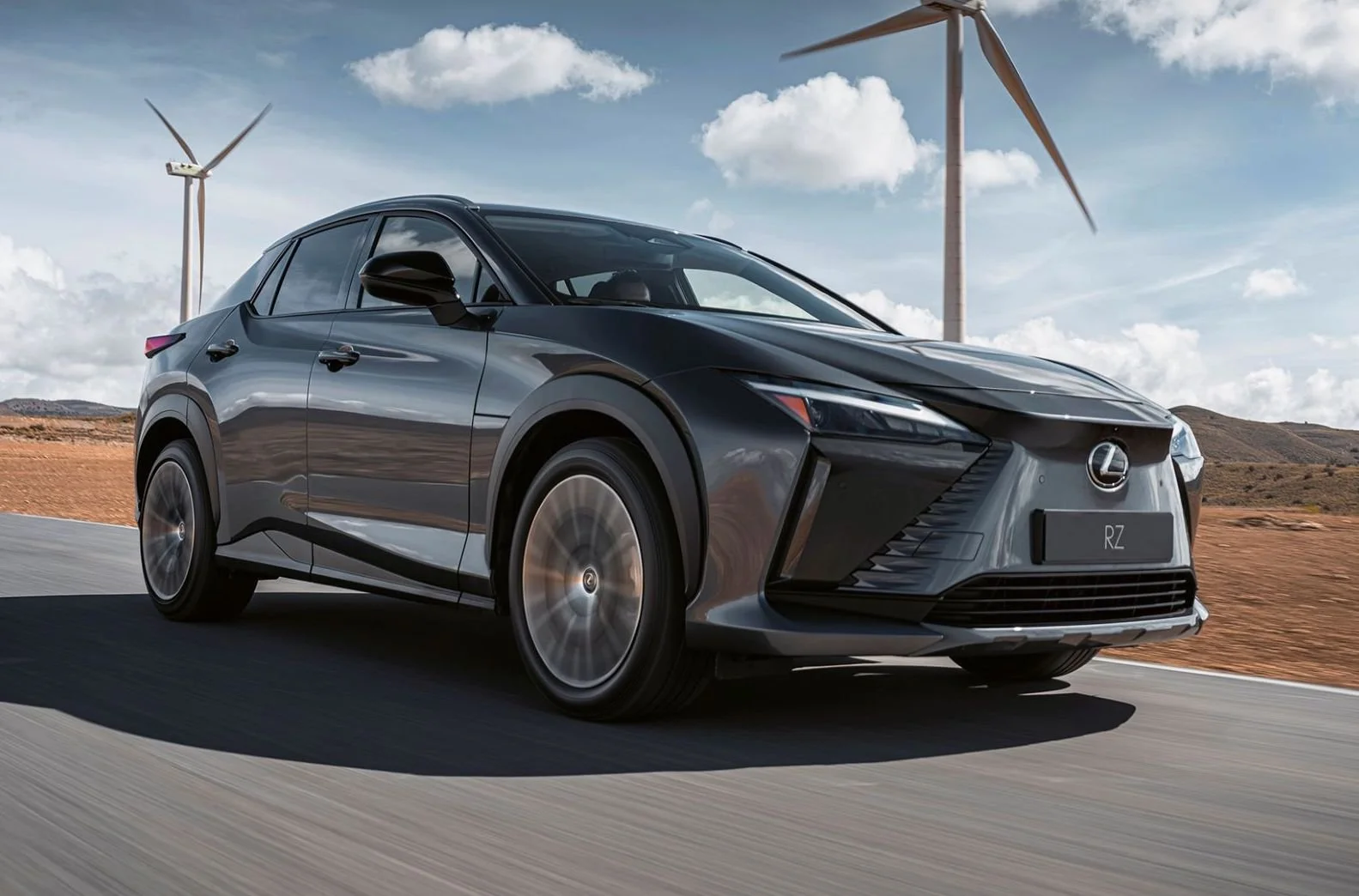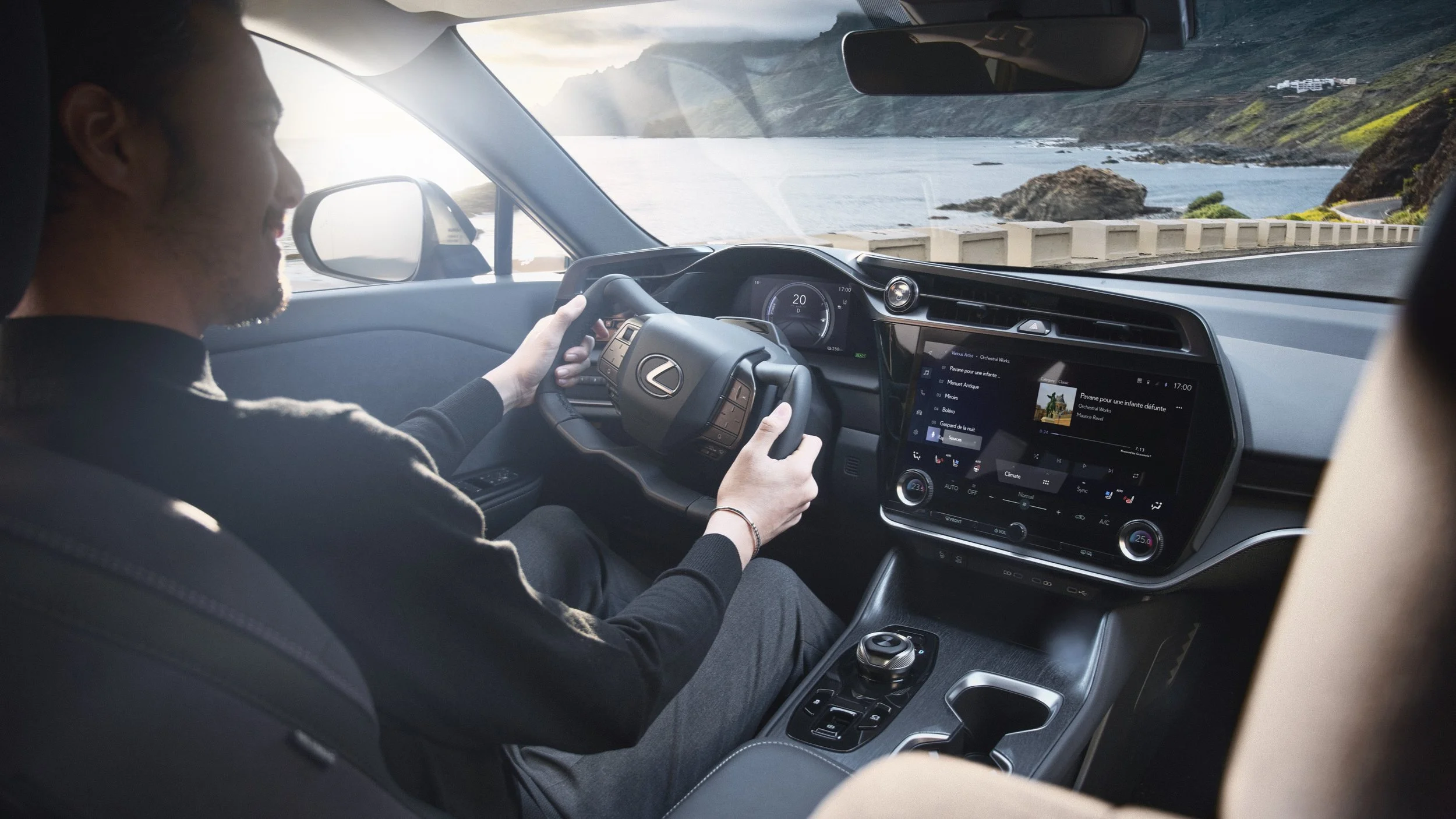Lexus RZ electric set to land in May
/Upmarket version of the Toyota BZ4X (and a certain Subaru) will sell in two trim levels.
AN important electric Lexus sharing a high degree of technical commonality with a more mainstream-themed Toyota and its Subaru sister ship will be here within eight weeks and ultimately will avail with a fascinating steering feature.
Arrival in May is confirmed for the RZ 450e and pricing has also been signed off - $141,600 for an entry Core derivative and $151,600 for a higher-provisioned Dynamic, with the only option being a special two tone paint finish for the flagship, for $2000. Orders are being taken from now.
The crossover-look model is an upmarket spin with bespoke styling, that blends styling aspects of both the NX and RX sports utilities, to plainly distinguish from the more obviously twinned Toyota bZ4X and Subaru Solterra crossovers also confirmed for New Zealand availability in 2023 but with no firm arrival timings shared. Those cars have also yet to be priced.
All three place on the same e-TNGA architecture and all draw off a 71.4kWh (65.6kWh usable) battery.
The Lexus only provisions with dual motors, whereas the others have a front drive option that might not sell here anyway, these having been tuned to deliver additional oomph behind the bent L badge.
One factor under the spotlight is the car’s range.
Lexus NZ’s communication today has used a range figure it says was provisioned by head office in Japan, based on the NEDC measurement scale, which while still recognised in NZ, is considered outdated and less accurate than the WLTP assessment that officially replaces it and has become a far more barometer.
NEDC lends a more flattering outcome and that seems to be evidenced here, with the brand suggesting the car will achieve 470km before requiring replenishment - whereas WLTP says 450km, which is 8km behind BZ4X.
According to independent overseas’ reports, however it plays out, tangibly better range will come from the Core, simply because it runs 18-inch wheels whereas the Dynamic is on 20 inch rims.
Though not the first Lexus electric car in the local line-up – that title goes to the UX300e that landed almost two years ago – the RZ is the first one developed as an electric vehicle from the ground up and it’s of great importance for Lexus, whose electrified product lineage is well recognised having begun in 2006 with the Lexus RX400h.
Lexus NZ mostly sells hybrids and plug-in hybrids here – the big exception is the Land Cruiser 300 Series-based LX - and plans to only sell electric cars by 2030 in North America, Europe, and China, and in the rest of the world by 2035.
Attractions beyond the rakish shape could be the count of innovative features such as steering-by-wire and the option, in some other markets from mid-2023 and set - Lexus NZ said today - to come to NZ at some point, of a Tesla-style yoke instead of a conventionally round steering wheel. It also has a system that inhibits an occupant unwittingly opening a door into traffic when a close call is sensed.
Another interesting feature is that it can be recharged through ports on both sides of the car, though the ports aren’t uniform – one is a CCS outlet, the other a Type 2 charger.
At 4805mm long, the Lexus is 5mm shorter than the Toyota, is wider (1895mm versus 1860mm), is 35mm higher and unsurprisingly exact-matches on wheelbase, with a 2850mm measurement.
The all-wheel drive system, which Lexus labels as Direct4, combines two motors front and rear to deliver a total 233kW – so, about 73kW above the output cited for bZ4X.
Lexus has yet to share a torque figure – with BZ4X and Solterra there’s 336Nm – but, again, independent international data suggests it could be around 450Nm.
The 0-100kmh is around 5.5 seconds, whereas the BZ4X and Solterra are a 7.7 second sprinters. The cars has a 750kg braked/unbraked towing rating.
Power delivery is biased towards the front wheels because of the more powerful 150kW motor up front (the rear pumps 80kW), though the system is controlled by a network of sensors and ECUs meaning that in tricky situations or conditions, power is always sent where it's most needed.
Andrew Davies, who heads Lexus here and having previously been known as the national general manager is now going by the mantle of vice president of Lexus New Zealand (to globally align with overseas’ practice), is calling RZ 450e “our future of electrification” and a car that will continue to accelerate his brand’s carbon reduction journey.
“From the brave design through to the exhilarating performance it will be a delight to drive. And of course, being a Lexus, the build quality and luxury interior will be second to none,” he says.
Apart from being on larger wheels, the Dynamic also delivers the added elements of a power dimming panoramic roof, adaptive high-beam headlights, what’s being called an ‘ultrasuede’ seat fabric (Core has synthetic leather) and a head-up display.
There are six exterior colour choices as well as three two tone choices for the Dynamic.
Despite the technical commonality, it might be difficult to see too much styling similarity as RZ has all the latest Lexus design ingredients that lend a more rakish and hunkered appearance than Toyota (and Subaru) have gone for.
The RZ's front end incorporates a new take on the signature spindle-shaped Lexus grille – which, as an electric vehicle, it doesn’t really need. The rearward part of the roofline includes two small aero-optimised fins. Lower down, below the rear spoiler lip, a light bar extends the full width of the tailgate.
The driver views a simple instrument cluster with the 14.0-inch infotainment screen angled towards the driver and within easy reach. Buttons haven't been totally eliminated with some hard controls remaining for the heating and climate control functions.
The Dynamic’s glass roof has been given a special coating to block out solar radiation (and thus heat) and to keep warm air inside. Aimed at the driver and passenger's knees, a new heater radiates warmth to give the effect of “a warm blanket around the legs”. Again, Lexus says that this is for efficiency as much as comfort as using the heated seats, steering wheel and knee-warmer uses less energy than warming the entire cabin.
At launch the RZ will available with a conventional round steering wheel, but the yoke is coming. “The yoke steer-by-wire system will be made available to New Zealanders, but this option is not available at the time of this model launch,” says Lisa Saunders, the make’s national head of public relations and communications.
The chief advantage of this, according to Lexus, is that it gives the driver a clearer view of the instrument binnacle as well as eliminates hand-over-hand turns thanks to its 150 degrees of angle between straight ahead and full lock.
Both the conventional steering wheel and yoke connect to a steering-by-wire system which, in doing away with traditional linkages, reduces the level of unnecessary feedback between the front wheels and the driver's hands making the RZ more stable over rough ground or in crosswinds. There’s a separately-powered back-up system to enact should the primary system fail. BZ4x has the same system, which Toyota calls ‘One Motion Grip’.
The RZ achieves a full suite of driver assistance and safety features including Proactive Driving Assist which monitors the road ahead with a camera and can adjust the steering enabling the car to make the turn.
The e-Latch system links the electronically opening doors with the vehicle's Blind Spot Monitor to inhibit the driver or passenger opening a door into the path of an oncoming car or cyclist. This aims, Lexus says, to prevent 95 percent of these types of accidents.
Lexus NZ has not cited rivals but conceivably the car might cross-shop against cheaper European elites. Two potentials are the Audi Q4 e-tron, which provisions from April in sports utility and Sportback five-seater body styles in 150kW/310Nm single motor, rear drive Advanced (Q4 40 e-tron) and 220kW/460Nm dual motor S-Line (Q4 50 e-tron quattro), all with more than 500 kilometres’ WLTP-cited range and costing up to $126,990 and the BMW iX3 ((210kW/400Nm drivetrain and up to 460kms’ range WLTP. Also the $139,990 Kia EV6 GT, 430kW/740Nm, with 424kms’ WLTP claimed.






















